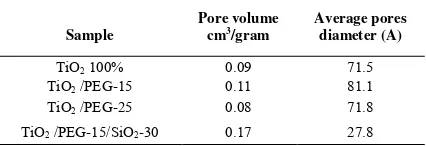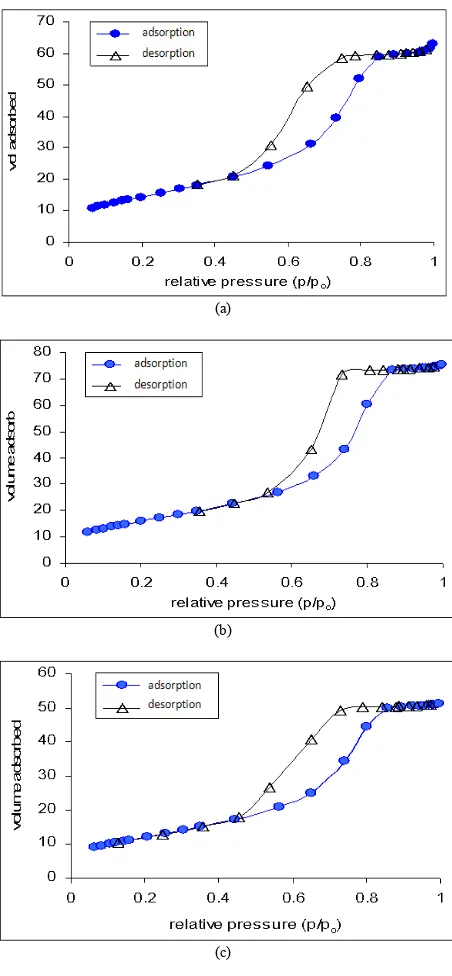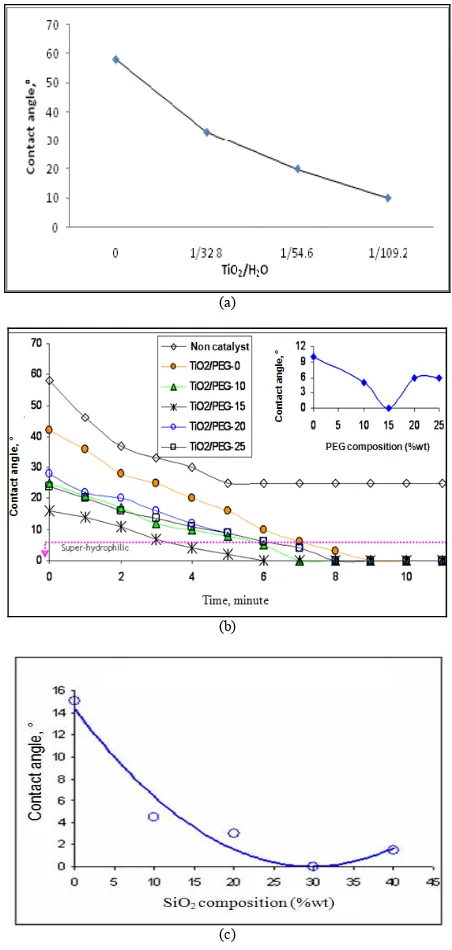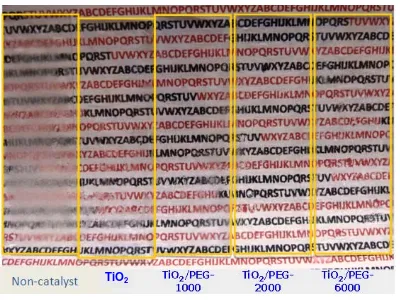Modification of TiO
2
Nanoparticle with PEG
and SiO
2
For Anti-fogging and Self-cleaning
Application
Dewi Tristantini, Slamet, Rini Mustikasari, Widuri
Department of Chemical Engineering, Faculty of Engineering, University of Indonesia Kampus UI Depok, Depok 16424, Indonesia
E-mail: [email protected]
Abstract - Photocatalytic process over TiO2 has been
developing and employed in many applications. One of its applications is used as self-cleaning and anti fogging material. The hydrophilic properties of its material allow water to spread completely across the surface rather than remaining as droplets so it can perform self-cleaning and anti-fogging effects. Some studies have been done to enhance the performance of this photocatalyst by using kinds of additives. In this study, PEG and SiO2 are used simultaneously and added to TiO2 photocatalyst that prepare by using TiAcAc
precursor. The addition of these additives is varied in composition until optimum condition achieved. From SEM, BET, XRD, and FTIR characterization and also activity test by using contact angle meter, optimum condition was achieved in addition of PEG 15% weight and SiO2 30% weight. In this
composition, catalyst can perform self cleaning and anti fogging effects even in minimum light condition. Combination of PEG and SiO2 addition can also improve catalyst
performance such as crystal structure, crystal size, porosity and surface area.
Key words: nano particle, TiO2, hydrophilic, PEG, SiO2,
self-cleaning, anti fogging.
1. INTRODUCTION
Environmental pollution, dust and other particulates in air could make glasses, ceramics or other outdoor materials become dirty easier. Fog causes some problems in transparency and also visual aspect of material especially glass material. Intensive cleaning is needed to maintain its optical properties and also keep it clean and sterile. Conventional cleaning requires detergent/chemicals, workers, and also equipments that costly enough. This problem encourages to reach a better properties of outdoor materials.
Semiconductor catalyst TiO2 has been known for its
strong oxidation power and also hydrophilic properties during UV irradiation. It allows water to spread until the water contact angle become 0° across the surface rather than remaining as droplets [1]. This phenomenon could avoid fog formation that makes reduction of glass visualization. Furthermore, its hydrophilic properties causes the degradation of organic pollutant, such as dust and oil in the TiO2 coated surfaces and in turn make it easy to be
cleaned [2,3].
TiO2 catalyst is generally on the powder form so needs
special treatment before it is applied on a surface. Besides
that, TiO2 is very difficult to be separated from the
suspension when its fabrication done. Because of those
reasons, we develop a TiO2film catalyst. Some researches
had been done to improve this photocatalytic activity in film form [1,4, 5,6,7,8].
Some additives are needed to make excellence catalyst performance. TiO2 film modification with PEG and SiO2
additive had been done separately by other researches [1,4,6,7,9,10,11], but the combination of those additives has not been studied so far. According to the previous studies, PEG could increase hydrophilic properties, porosity, and decrease crystal size and cracked film possibility. SiO2
could increase acidity of the catalyst, so it can improve hydrophilic properties of catalyst even without irradiation.
In this research, PEG and SiO2 will be added
simultaneously to make a film with super-hydrophilic properties that could work in the less-irradiation environment for antifogging and self-cleaning application in the future.
2. EXPERIMENT
2.1. Catalyst Preparation
The first step of preparation was making a solution of Titanium Isopropoxide bis acetic acetonat [Ti(OPr)4 AcAc]
and ethanol. Another solution contained de-mineralized water (with Milipore), HCl 37% and ethanol. The first solution and the second solution were mixed and water was added with variations of ratio water to Ti(OPr)4 AcAc until
the optimum condition.
Then, the solution was sonicated with Cole-Parmer
Ultrasonic Cleaner 8848 for 30 minutes to make a homogenous solution. The result is a yellow transparent solution. The larger number of water that is added, the more transparent solution will be formed. After ultrasonic
process, various amount of PEG 2000 (MERCK –
Schuchardt) is added as 0%, 5%, 10%, 15%, 20%, and 25% from TiO2 catalyst weight.
For SiO2 variation, Si solution was made from TEOS
98% with water, HNO3 and ethanol. Then, Si solution was
refluxed for 2 hours on the hot plate at 75° C. Reflux must be done in order to make TEOS hydrolysis faster. After that, both solution, Ti with PEG solution and Si solution were mixed together to get catalyst sol with desired weight presentation. In this study, the variations of Si are 10% until 30% from catalyst weight.
1110702-8383 IJET-IJENS @ April 2011 IJENS
Spin coating is used for this process in 3 minutes with 400 rpm for each coating. Every SLP was coated 3 times. Coated SLP were dried in 100° C for 60 minutes, and increase the temperature 6 C/min to 520° C kept on it for 60 minutes.
2.2. Photocatalyst Activity Test
Catalysts from preparation process are tested
qualitatively and quantitatively. Quantitative test have been done with contact angle meter under with and without UV irradiation condition. The measurement was held from the first minute until the contact angle reach 0°. Qualitative test had been done directly with camera.
2.3. Catalyst Characterization
Characterizations of these research are SEM, FTIR, BET , XRD and DRS. The crystalline phase of samples were determined using powder X-ray diffraction (XRD).
The XRD patterns were obtained from X-Ray Cu K with
Cu tube, operated at 40 kV and 35 mA. The 2 scanning
range was 2θ = 55o. The crystalline of samples were
estimated by Scherrer equation. A UV-Vis 2450 (UV Probe Shimadzu) was used to record the diffuse reflectance spectra (DRS) of the samples. Reflectance spectra were analyzed under ambient condition in the wavelength range of 240-560 nm. The specific surface area of catalysts was
measured by BET of N2 adsorption in a Quantachrome
autosorb-6. A SEM 515 PHILIPS scanning electron microscope (SEM) equipped with EDAX PV 9900 PHILIPS energy dispersive X-ray (EDX). A Mattson FT-IR Fourier Transform infrared (FTIR) spectrometer genesis senes type was also used to record FTIR spectra using KBr disc in technique in the air. The range of wave number was 500-4000 cm-1
3. RESULT AND DISCUSSIONS
3.1. SEM Characterization
From the SEM characterization result (Figure 1), it could be seen that PEG could distribute catalyst aggregate better in the film surface. Sample with PEG 15% shows that aggregate distributions on the film surface are more homogenous compare with sample 100% TiO2.
Figure 1.SEM Characterization of TiO2 in various compositions, (a). TiO2 100%, (b). TiO2 /PEG-15%, (c). TiO2 /PEG-25, (d). TiO2 /PEG-15%/SiO2-30
In spite of aggregate influence distribution on film surfaces, SEM results show additives effect on the size of the aggregate of catalyst. Table 1 gives data of catalyst aggregate size in various compositions of catalysts.
Table 1. Aggregate size of TiO2 in various compositions
Those calculations indicate that the more amount of PEG, the smaller aggregate of catalyst and more homogenous catalyst will be formed. The decreasing of catalyst’s aggregate during PEG addition is caused by PEG ability to barrier the interaction among Ti particles. However, there is a contadiction result in addition of 25% PEG into the catalyst. The particle aggregate size was increased. This phenomenon is predicted as the effect of PEG molecule’s saturation that could disturb Ti particle distribution on the catalyst. In this case, addition of silica shows an increase number of particle size of catalyst and also homogeneity.
3.2. BET Characteization
The result of BET characterization is shown in Tabel 2 bellow.
Table 2. Surface area of TiO2 in various compositions
It is proof that the addition of PEG could increase surface area of catalyst, but it is not significant. Adding 15% PEG just increases a little surface area compare with sample without PEG. Surface area becomes decreased after addition of 25% PEG and that PEG 25% becomes saturated and covers with TiO2 structure. The PEG addition makes a
decrease of surface area. Those indicate there must be an optimum condition. In this case, we found the optimum condition is on 15% PEG. This is supported by the faster decreased contact angle of 15% PEG than the other PEG variations. And then, after adding SiO2 on the PEG 15%,
surface area of catalyst increases significantly until 248
m2/g. The SiO2 could inhibit particle grows during
calcinations because of mixed oxide bond Ti-O-Si, which could inhibit the interaction among Ti particles [5].
Table 3. Volume and average diameter of pores of TiO2 in various compositions
Sample Aggregate size (µm)
TiO2 100% 5.5-9.1
TiO2 /PEG-15 1.7-7.1
TiO2 /PEG-25 > 10
TiO2 /PEG-15/SiO2-30 1.6-4.8
Sample Surface area (m2
Beside influence surface area of the catalyst, BET characterization shows that the addition of PEG could increase the volume and also pores of catalyst. This is in
line with Miki et al.’s research which average pores
diameter is about 3.5 nm, but has less pores volume. One reason could be water evaporation as dispersion phase and also PEG burn during calcinations [10].
BET characterization gives information about the type and also form of pores from catalyst. From Figure 2 we find out that the adsorption curve follows different type of curves. PEG 0, 15 and 25% adsorption follow type IV which shows mesopore size (20-500 Å). PEG 15% and
SiO2 30% follows adsorption curve type IV which is
micropore size or the particle size is less than 20 Å [13].
(a)
(b)
(c)
Figure 2. Hysteresis curve of TiO2 in various compositions, a. TiO2 100%, b. TiO2/PEG-15%, c. TiO2/PEG-25, d. TiO/PEG-15%/SiO-30%
PEG 0, 15, and 25 % have type A form (cylinder pore). In other side, PEG 15% and SiO2 30% have type E
form, which is like a tint bottle with smaller size in the edge [13].
3.3. XRD Characterization
The result of this characterization is shown in Figure 3. From the XRD characterization could be known that almost all of the crystal type is anatase (peak around 2θ=25°) except on PEG 15%. We found rutile phase on the PEG 15% (peak around 2θ=27°).
Figure 3. XRD Result of TiO2 samples
Table 4 bellow shows the comparation of type and size of crystal that is resulted in various additives after Scherrer calculation.
Table 4. Rutile fraction and crystal diameter of TiO2 samples
Based on crystal size, we can see a decrease crystal size by adding PEG and SiO2. This result indicates that
PEG and SiO2 could inhibit interaction between Ti particles
during calcinations process [7].
3.4. FTIR Characterization
FTIR characterization (Figure 4) shows there are peaks
in 3000-3500 and 1600 cm-1 wave numbers. The wave
number of 3000-35000 cm-1 indicates there is hydroxyl (OH-) and 1600 cm-1 wave number indicates chemisorbed
water (H-O-H) on each sample.
The amount of hydroxyl and H-O-H bond is increased by the increasing of PEG amount. The optimum condition
is PEG 15%. Beside that, peak around 2900 cm-1
wavenumber was founded in pure TiO2 and TiO2 with PEG
variated. It is indicated there are some alkyls (C-H) which is predicted as imperfect evaporation of PEG that excess carbon deposit in catalyst surface. Addition of silica in PEG 15% shows the increasing of hydroxyl and chemisorbed water amount.
There are two new absorbencies in the catalyst with PEG and SiO2 addition and these do not appear on the other
samples. It is on 1056.79, and 933.37 cm-1 wavenumber.
Sample Rutile
fraction
crystal diameter (nm)
TiO2 100% 0 10.7
TiO2 /PEG-15 0.017 9.2
TiO2 /PEG-25 0 8.1
1110702-8383 IJET-IJENS @ April 2011 IJENS
Based on the Guan et. al.’s report, the two peaks around those wavenumber is assumed as asymmetric stretching vibrations from Si-O-Si and Ti-O-Si bonds. On the other hand, there are peaks around 2300 cm-1 that show Lewis bond. Lewis bond or Lewis acid is formed when a molecule has an over positive charge or conduct as electron receptor. In this case, this sample can conduct to be an OH- receptor which comes from water in the air. The peak on the
addition of PEG 15% and SiO2 30% indicate the more
amount of OH- that can be adsorbed. It is caused by the addition of Si increases the acidity of catalyst surface, so it is easier to catch OH- in the air. In Figure 4 below we will see FTIR spectra from powder catalyst with PEG variation
0, 15 and 25% and also TiO2/PEG-15/SiO2-30 on the
wavenumber range of 500-4000 cm-1.
From the FTIR characterization, it can be concluded that TiO2 catalyst preparation with addition SiO2 30% does
not only form single oxide particle, but also mixed oxide bond (Ti-O-Si) in the wave number around 900 cm-1. This result is also proving Guan et al. (2003)’s research which is by adding SiO2 on the catalyst, super-hydrophilic properties
will be formed in the film [7].
Figure 4. Absorbance curve on FTIR characterization of TiO2 samples
3.5. DRS CHARACTERIZATION
Band-gap of TiO2 could be maintained from DRS
result. Figure 5 shows TiO2 catalyst which is prepared with
sol-gel method has gap value as 3.17 eV. This band-gap is almost same with anatase crystal band-band-gap, 3.20 eV. PEG and SiO2 could increase band-gap value of TiO2 from
3.17 to 3.28 eV
Figure 5. DRS characterization result
Beside its function to disperse and stabilize nano-sized particle TiO2, silica could influence electron properties in
the semiconductor catalyst, such as quantum size effect and support effect. Quantum sized effect could enlarge band-gap result in increasing of energy band-gap [11,14,15]. Lassaletta
et al. concluded that increased band-gap energy on the titanium-silica catalyst is a combination between quantum sized effect and support effect [16]. Those could increase band-gap TiO2 (anastase) from 3.23 eV to 4.10 eV on the
titanium-silica.
3.6. CATALYSTS ACTIVITY TEST
3.6.1. Contact angle meter test
(a)
(b)
(c)
Measurement of contact angle had been done in some variations. Those were the ratio of TiAcAc/water, PEG and SiO2 addition.
The first measurement is for TiO2/water ratio. There
are three variations in mol, 1/32.8, 1/54.6, and 1/109.2. Those three of samples have no additional additive such
PEG or SiO2. The result, as in Figure 6 (a), shows
decreased contact angle trend by adding more water in to the solution. Experiments to obtain the optimal value should be continued.
Figure 6 (b) shows that in general the addition of PEG can decrease significantly the contact angle of water. It is indicated hydroxyl from PEG is still on the film catalyst TiO2, so it can change the hydrophobic properties of SLP.
Hydroxyl could reduce surface tension between water and SLP surface, therefore the catalyst could reduce contact angle until 0º.
The results showed that more PEG is added, the contact angle decreases until at a certain condition. It indicates that the more amount of PEG, the more hydroxyl will be formed, as shown in the FTIR characterization at wavenumber of about 3500 cm-1. The optimum condition is
on the 15% wt.
On the sample with the addition of SiO2, the graph
(Figure 6.c) indicates sample with silica shows less contact angle. A low contact angle can be achieved when stabilized hydroxyl formed in the surface. So when the water comes, it can be bonded with hydroxyl to form multilayer hydroxyl that can make the surface more hydrophilic.
From this activity test, we know the addition of SiO2
can improve the catalytic activity of TiO2 by increasing
acidity in the surface as shown in Figure 6(c). This acidity formed because of silica’s cations which enter oxide lattice from TiO2 is still bonded with oxygen, but the oxygen now
has a new coordination. So, it makes an unbalanced charge [1]. This unbalanced charge will be neutralized by formation of Lewis bond between water with catalyst surface. With the acid surface, hydroxyl will be formed more, so that hydrophilic properties of catalyst can be increased and can be kept even though in the less irradiation condition [1].
FTIR Characterization shows that sample with addition
of SiO2 30% can form mixed oxide Ti-O-Si in the wave
number around 900 cm-1. This acidity is caused by Ti-O-Si
bond and does not come from photocatalytic process. It can explain why sample with silica still shows good performances even though without UV irradiation. The same thing was explained from Guan e. al. that the decrease
of contact angle is not shown significantly with SiO2
addition [7]. Guan et al.’s research held in SiO2 > 30%. So,
it can be said that addition of silica could increase and kept hydrophilic properties of TiO2 even in the less irradiation
because of those mixed oxide [7].
From BET, it can be known that silica can increase the surface of catalyst. With the larger surface area, it is easy to adsorb water to produce more hydroxyl. This hydroxyl can be formed with chemical and adsorption on the surface of TiO2 film.
With more chemically adsorbed OH, van der Waals force and the interaction hydrogen bond between water and hydroxyl will be increased so when the water come, it easily spread off and the surface become hydrophilic. The optimum SiO2 composition of this test is 30% SiO2
3.6.2. Antifogging Test
This test proposed to show up the effect addition of PEG in various molecule weights. This test is qualitative test by using digital camera,as shown in figure 7.
From that figure we see that the addition of PEG in various molecular weights decreases contact angle (without any fogging), but one and others are not so different in the qualitative test. Those three samples give almost same performances. It indicated that PEG with molecular weight 1000-6000 is effective enough to modify TiO2 film so that
they could have high hydrophilic properties.
Figure 7. Antifogging test at the minute 0, 5 and 10 on SLP
3.6.3. Self-Cleaning Test
For self-cleaning test, ceramic is coated with TiO2 with
PEG and SiO2 addition with the optimum condition. This is
to prove whether the catalyst with high hydrophilic activity for antifogging application can be used in self-cleaning application. The test is held by put the ceramic in the open air, in the kitchen, and in the bathroom for 1 month. This test is proposed to see the self-cleaning effect in the open air, kitchen, and bathroom, because every part represents different self-cleaning activity of different particulate. For example: dust, particulate and free radicals from open air, while particulate and organic (dust and lichens) from the bathroom.
Figure 8. Contact angle test for TiO2 and its modifications
From the result it is found that TiO2 coated ceramic is
relatively not dirty and easy to be cleaned by rain water compared with other ceramic without catalyst. Beside that,
1110702-8383 IJET-IJENS @ April 2011 IJENS
in the bath room, the surface of the non-coated ceramic is more slippery than coated one. This is indicated a lot of particulate in the surface of non-coated ceramic, even it can not be seen enough by naked eyes. This condition shows that by addition of PEG and SiO2 on the TiO2 catalyst,
coated ceramic can be used in self cleaning application. Self-cleaning test had been done also in glass ceramic. The result can be shown in Figure 8. From the figure, we can see that the catalyst with the PEG 15% and silica 30% gives the most optimum performance. This is suitable with contact angle measurement that this catalyst has the lowest contact angle.
4. CONCLUSIONS
The modification of TiO2 Nanoparticle with PEG and SiO2
For Anti-fogging and Self-cleaning Application study has been done with some conclusions as follow:
1. Addition of PEG on TiO2 catalyst could increase
porosity, hydrophilic properties, band-gap and surface area. The PEG can reduce crystal of the catalyst, but the change is not significant. Optimum condition in addition of PEG is 15% weight.
2. Addition of silica on the catalyst TiO2 could increase
acidity of catalyst, so that the catalyst still has hydrophilic properties and kept it active even though less irradiation. The silica could inhibit particle growth during calcinations by producing nano size material.
Optimum composition from addition of SiO2 is 30%
weight.
3. The addition of PEG and SiO2 simultaneously could
improve performance of catalyst TiO2 including
hydrophilic properties, activity, particle size, and also porosity of the catalyst. For antifogging and self cleaning, the optimum composition is PEG 15% weight and SiO2 30% weight.
ACKNOWLEDGEMENT
The authors would like to thank Directorate of Research and Community Services (DRPM UI), University of Indonesia for the financial support on this research through ‘Riset Unggulan Universitas Indonesia’ Research Project.
REFERENCES
[1]. K. Guan, Relationship between Photocatalytic
Activity, Hydrophilicity and Self-Cleaning Effect of TiO2/SiO2 Films, Surf. Coat. Technol. 191 (2005)
155-160.
[2]. T. Kemmit, N.I. Al-Salim, M. Waterland, V.J.
Kennedy, A. Markwitz, Photocatalytic Titania
Coatings, Current Appl. Phys. 4 (2004) 189-192. [3]. T. Nuida, N. Kanai, K. Hashimoto, T. Watanabe, H.
Ohsaki, Enhancement of Photocatalytic Activity
Using UV Light Trapping Effect, Vacuum. 74 (2004) 729-733.
[4]. B. Guo, Z. Liu, L. Hong, H. Jiang, J.Y. Lee,
Photocatalytic Effect of the Sol-gel Derived Nanoporous TiO2 Transparent Thin Films, Thin
Solid Films. 479 (2005) 310-315.
[5]. H. Han, L. Zan, J. Zhong, L. Zhang, X. Zhao, The
Preparation of High Surface Area Nanocrystalline
TiO2 Films Using Easy-Reaggregation Particles in
Solution,Mat. Sci. and Eng. B. 110 (2004) 227-232. [6]. J. Yu, X. Zhao, Q. Zhao, G. Wang, Preparation and
Characterization of Super-hidrophylic Porous TiO2
Coating Films, Mat. Chem. & Phys. 68 (2001)
253-259.
[7]. K. Guan, B. Lu, Y. Yin, Enhanced Effect and
Mechanism of SiO2 Addition in Super-hidrophylic
property of TiO2 films, Surf. Coat. Technol. 173
(2003) 219-223.
[8]. T. Miki, K. Nishizawa, K. Suzuki, K.ato,
Preparation of Nanoporous TiO2 Film with Large
Surface Area Using Aqueous Sol with Trehalose,
Mat. Lett. 58 (2004) 2751-2753.
[9]. X. Liu, J. Yang, L. Wang, X. yang, L. Lu, X. Wang,
An Improvement on Sol-Gel Method for Preparing Ultrafine and Crystallized Titania Powder, Mat. Sci. and Eng. A . 289 (2000) 241-245.
[10].T. Miki, K. Nishizawa, K. Suzuki, K. Kato,
Preparation of Thick TiO2 Film with Large Surface
Area Using Aqueous Sol with Poly(ethylene glycol),
J. Mat. Sci. 39 (2004) 699-701.
[11].C. Anderson, A.J. Bard, An Improved Photocatalyst of TiO2/SiO2 Prepared by a Sol-Gel Synthesys, J.
Phys. Chem. 99 (1995) 9882-9885.
[12].C. Anderson, A.J. Bard, J. Phys. Chem. B 101
(1997) 2611.
[13].Autosorb-6B Manual Book, Quantac Corporation
Gas Sorption System, 1992.
[14].H. Inoue, T. Matsuyama, B. Liu, T. Sakata, H. Mori, H. Yoneyama, Chem. Lett. (1994) 653.
[15].G. Dagan, S. Sampath, O. Lev, Chem. Mater. 7
(1995) 446.
[16].G. Lassaletta, A. Fernandez, J.P.Espinos, A.R.



